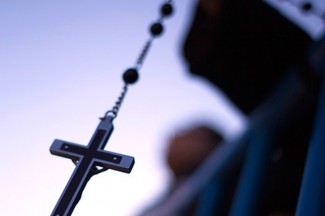
October is the month of the Rosary, and October 7, the Catholic Church celebrates the Feast of Our Lady of the Most Holy Rosary. The term “rosary” comes from the Latin word “rosarium,” meaning rose garden, and refers to the religious practice of reciting prayers, as well as to the string of beads used for this purpose. In Catholicism, the rose is a symbol of perfection. The Rosary, therefore, expresses an image of a perfect garden of prayer. Christians use it to count the prayers they are reciting, while meditating on particular events in the life of Jesus and his mother.
The Rosary is closely linked to Mary, the Mother of Jesus. Legend has it that St. Dominic received the Rosary from the Blessed Mother, and Mary has asked in other famous apparitions that people pray the Rosary, such as in the Miracle at Fátima in Portugal. It is interesting to note that Scripture tells us Jesus performed his first miracle at the request of his Mother during the wedding feast at Cana. For Catholic Christians, our Blessed Mother Mary’s power comes from her role as intercessor on our behalf. One of the most profound expressions of that influence is the Marian Rosary.
Ancient practice
I have recited and meditated on the Rosary since I learned it from my mother as a child. My mother learned to pray the Rosary from her mother. When I have prayed the Rosary for my own needs and those of others, I have rarely been disappointed with the results.
Although the history of the Rosary in Catholic practice dates to 1520 when Pope Leo X officially approved it for use by the laity, the concept of the Rosary was, according to tradition, given to St. Dominic in an apparition of the Virgin Mary in the year 1214 in the church of Prouille. This Marian apparition received the title of Our Lady of the Rosary.
The use of prayer beads is an ancient practice spanning Hindu, Buddhist, Muslim and Christian religious traditions and many different cultures. Did you know that more than two-thirds of the world’s population uses prayer beads as part of their religious practice?
Power of prayer
Certain prayers and rituals are handed down from generation to generation because they are believed to have the power to bring us closer to God and to influence the occurrence and/or outcome of events, circumstances, behavior, etc. Often today, we are told not to expect our prayers to be answered — at least not in the way we want them to be. While there are good reasons behind this argument, I also feel it has become so overstressed in some religious circles that many people have lost faith in the power of prayer.
I have recited and meditated on the Rosary since I learned it from my mother as a child. My mother learned to pray the Rosary from her mother. When I have prayed the Rosary for my own needs and those of others, I have rarely been disappointed with the results. And I am not alone!
Miracles associated with the Rosary
Many miracles around the world have been attributed to the Rosary, from the 1591 victory of the Christian army over the Turks, to 1955, when Russia signed an agreement to withdraw from Austria. One of the most well-know miracles occurred in Fátima, a small village in the country of Portugal, where three young children claimed a lady appeared to them on multiple occasions, referring to herself as the “Lady of the Rosary” and asking that they pray the Rosary every day. In addition to these, there are countless miracles described by individuals, churches, and groups throughout the world. But perhaps the greatest miracle of all is the miracle of hope that this simple prayer has given to millions.
The Rosary is just one example of the important place that prayer has in the Christian life. It gives us hope and a reason not to fear the future because we believe in a God who answers our prayers. How do we know this? Matthew’s gospel tells us that Jesus said:
“Ask, and it will be given you; search, and you will find; knock, and the door will be opened for you. For everyone who asks receives, and everyone who searches finds, and for everyone who knocks, the door will be opened. Is there anyone among you who, if your child asks for bread, will give a stone? Or if the child asks for a fish, will give a snake? If you then, who are evil, know how to give good gifts to your children, how much more will your Father in heaven give good things to those who ask him!”
How to say the Rosary
Here are a few helpful resources with instructions on how to pray the rosary on your own and/or with a community:
- “How to Pray the Rosary” from the U.S. Conference of Catholic Bishops
- “Come, Pray the Rosary” — a way to pray the Rosary live, online, with others
- “A Beginner’s Guide to the Rosary”
Want to say the Rosary on the go? Download one of the following rosary apps:
- iRosary
featuring colorful images and prayers (iPhone, iPad; $2.99)
- Virtual Rosary vibrates after every 10 Hail Marys (Android, free)
- Mobile Rosary
allows you to share a cause and intention on Facebook or Twitter (iPhone, iPad, Android; free)
- Rosary in many languages — available in Polish, English, German, French, Italian, Spanish, Portuguese and Japanese (Android, free)




